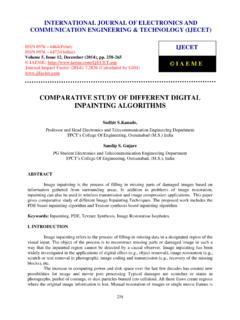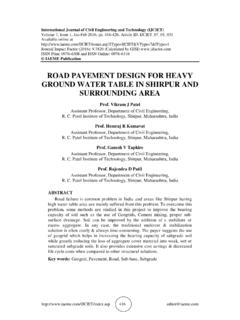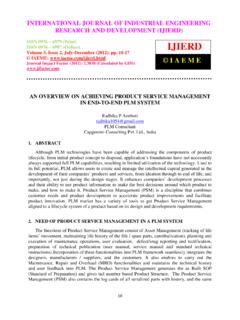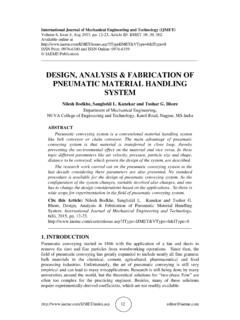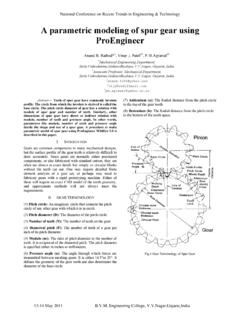Transcription of SPUR GEAR TOOTH STRESS ANALYSIS AND STRESS …
1 17 International Journal of Mechanical Engineering and Technology (IJMET) Volume 6, Issue 9, Sep 2015, pp. 17-29, Article ID: IJMET_06_09_003 Available online at ISSN Print: 0976-6340 and ISSN Online: 0976-6359 IAEME Publication _____ spur gear TOOTH STRESS ANALYSIS AND STRESS REDUCTION USING STRESS REDUCING GEOMETRICAL FEATURES M. Pramod Reddy Associate professor, Mechanical Department, Vijay Rural Engineering College, Nizamabad, INDIA M. Santhosh M. Tech Student, Mechanical Department, Vijay Rural Engineering College, Nizamabad, INDIA ABSTRACT The continuous meshing of the gears is generally leads to the failure of the gears. In order to avoid this problem we have to design the geometrical features of the gears very properly.
2 In the spur gears the TOOTH surface of the gears is exactly comes into contact with the other gear . in this study the STRESS is reduced between the gears by the STRESS reduction ANALYSIS using the geometrical features. Cite this Article: M. Pramod reddy and M. Santhosh, spur gear TOOTH STRESS ANALYSIS and STRESS Reduction Using STRESS Reducing Geometrical Features. International Journal of Mechanical Engineering and Technology, 6(9), 2015, pp. 17-29. 1. INTRODUCTION Gears are the most common means of transmitting power in the modern mechanical engineering world. They vary from a tiny size used in watches to the large gears used in lifting mechanisms and speed reducers.
3 They form vital elements of main and ancillary mechanisms in many machines such as automobiles, tractors, metal cutting machine tools etc. Toothed gears are used to change the speed and power ratio as well as direction between input and output. A primary requirement of gears is the constancy of angular velocities or proportionality of position transmission. Precision instruments require positioning fidelity. High-speed and/or high-power gear trains also require transmission at constant angular velocities in order to avoid severe dynamic problems. Constant velocity ( , constant ratio) motion transmission is defined as "conjugate action" of M.
4 Pramod reddy and M. Santhosh 18 the gear TOOTH profiles. A geometric relationship can be derived for the form of the TOOTH profiles to provide conjugate action, which is summarized as the Law of Gearing as follows: "A common normal to the TOOTH profiles at their point of contact must, in all positions of the contacting teeth, pass through a fixed point on the line-of-centers called the pitch point." 2. LITERATURE REVIEW The Lewis equation, as discussed before, is used for calculating bending STRESS for various tangential loads at different points on the TOOTH profile.
5 The drawback in the STRESS ANALYSIS of the gear TOOTH using this equation doesn t give the desired results at desired points on the TOOTH profile. Therefore, investigators, analyzing the gear TOOTH for stresses, have done several studies. Fredette and Brown [11] used holes drilled across the entire TOOTH as a function of size and location. The ultimate objective of this work was to find the overall effect of hole size and location on the critical stresses in the gear . Many of these researchers used the finite element ANALYSIS techniques for the ANALYSIS of the gear TOOTH . Wilcox, L [20] gave an analytical method for calculating stresses in bevel and hypoid gear teeth.
6 More recently number of authors had also done the ANALYSIS of the gears for the applied bending forces. Litwin, Chen, Lu, [13] and Handschuh [16] again applied finite element ANALYSIS on a loaded TOOTH for the determination of load share, real contact ratio, precision of motion and the STRESS ANALYSIS . It was the work done in parts by these authors Litwin did the determination of the load share, real contact ratio was determined by Chen and Lu and Handschuh did the STRESS ANALYSIS . A program was given by Gosselin, Claude, Clautier [12] predicting the motion error of spiral bevel gear sets under load, and explored some of the influences of the unloaded motion error curve shape and amplitude over the Kinematical behavior under load.
7 The effects of TOOTH composite deflection caused by bending and shearing, TOOTH contact deformation and initial profile separation due to profile mismatch were considered in the development. 3. gear NOMENCLATURE ADDENDUM (a) is the height by which a TOOTH projects beyond the pitch circle or pitch line. BASE DIAMETER (Db) is the diameter of the base cylinder from which the involute portion of a TOOTH profile is generated. BACKLASH (B) is the amount by which the width of a TOOTH space exceeds the thickness of the engaging TOOTH on the pitch circles. As actually indicated by measuring devices, backlash may be determined variously in the transverse, normal, or axial-planes, and either in the direction of the pitch circles or on the line of action.
8 Such measurements should be corrected to corresponding values on transverse pitch circles for general comparisons. spur gear TOOTH STRESS ANALYSIS and STRESS Reduction Using STRESS Reducing Geometrical Features 19 BORE LENGTH is the total length through a gear , sprocket, or coupling bore. CIRCULAR PITCH (p) is the distance along the pitch circle or pitch line between corresponding profiles of adjacent teeth. CIRCULAR THICKNESS (t) is the length of arc between the two sides of a gear TOOTH on the pitch circle, unless otherwise specified. CLEARANCE-OPERATING (c) is the amount by which the dedendum in a given gear exceeds the addendum of its mating gear .
9 CONTACT RATIO (mc) in general, the number of angular pitches through which a TOOTH surface rotates from the beginning to the end of contact. DEDENDUM (b) is the depth of a TOOTH space below the pitch line. It is normally greater than the addendum of the mating gear to provide clearance. DIAMETRAL PITCH (P) is the ratio of the number of teeth to the pitch diameter. FACE WIDTH (F) is the length of the teeth in an axial plane. FILLET RADIUS (rf) is the radius of the fillet curve at the base of the gear TOOTH . FULL DEPTH TEETH are those in which the working depth equals divided by the normal diametrical pitch. gear is a machine part with gear teeth.
10 When two gears run together, the one with the larger number of teeth is called the gear . HUB DIAMETER is outside diameter of a gear , sprocket or coupling hub. HUB PROJECTION is the distance the hub extends beyond the gear face. INVOLUTE TEETH of spur gears, helical gears and worms are those in which the active portion of the profile in the transverse plane is the involute of a circle. LONG- AND SHORT-ADDENDUM TEETH are those of engaging gears (on a standard designed center distance) one of which has a long addendum and the other has a short addendum. KEYWAY is the machined groove running the length of the bore.



